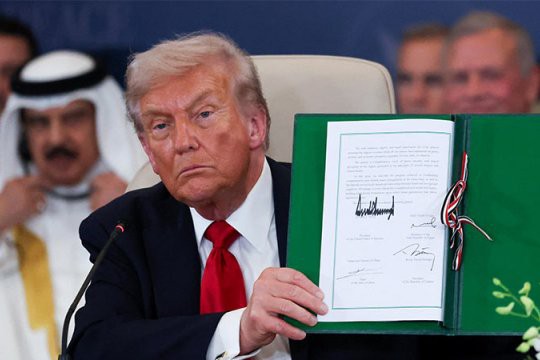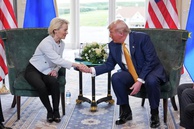Just a week after Donald Trump signed the Gaze peace agreement, statements coming from the US show that the deal is already under threat. Why?
On October 19, the State Department published a message on the X platform (formerly Twitter) about the threat of a ceasefire violation in Gaza. Washington blames the Hamas movement and has informed Qatar, Turkey, and Egypt – the guarantors of the peace deal - about its concerns. “The guarantors demand Hamas fulfill its ceasefire obligations, and pledged to take action to protect Gaza residents if attacks continue," the State Department stated in its message. i
The first serious disagreements popped up already on the evening of October 13 - the day the peace deal was signed in Sharm El Sheikh. Hamas was unable or unwilling to return the bodies of all killed hostages within the agreed timeframe, which angered high-ranking Israeli officials.
On October 14, Israel threatened to scale down the number of humanitarian aid trucks allowed into Gaza. On the same day, Israeli forces opened fire on Palestinians in northern Gaza, killing at least six people. According to the Israeli military, troops were in hot pursued of suspects who had crossed the US-agreed "yellow line" – the boundary for a partial withdrawal of Israeli forces from the area. However, a Palestinian news agency reported that Israeli drones had actually fired on residents inspecting their homes.
In an October 15 phone interview with CNN, President Trump said that he would allow Israeli Prime Minister Benjamin Netanyahu to resume military operations in Gaza if Hamas refused to comply with the ceasefire agreement and failed to give back the bodies of all dead Israelis. The American president also stated that Israeli forces could resume operations "instantly, at his signal," ii. The question is - who in fact commands the Israeli Armed Forces? On the same day, the press service of Israeli Defense Minister Israel Katz announced that he had ordered preparations for a "comprehensive plan to defeat Hamas" if the war in Gaza resumed.
Meanwhile, the head of the UN humanitarian affairs, Tom Fletcher, indirectly accused Israel of breaking its promise not to hinder humanitarian aid supplies to Gaza. Meanwhile, health officials in Gaza told The Associated Press that some of the 90 bodies returned by Israel since Monday showed signs of physical abuse. A member of the committee tasked with receiving the bodies at Nasser Hospital in Gaza said that the bodies bore "signs of torture and execution."
On October 16, Hamas issued a statement announcing the completion of the transfer of all recovered bodies of Israeli hostages. According to Hamas representatives, further searches require special equipment for clearing rubble. Israel, in turn, threatened to resume hostilities, accusing the Palestinian side of failing to fulfill the terms of the deal. It was against this backdrop that media warned that disputes over the timing of returning the remains of the Israeli hostages could be used as a pretext to derail the truce agreement.
On October 17, Israel expressed once again its utter unhappiness about that fact that not all bodies of Israeli hostages had yet been returned. On the same day, Mohammed Nazzal, a leader of Hamas' political bureau, stated that the group intends to retain control over security in Gaza during the transitional period and evaded a question about disarmament. iii According to Nazzal, Hamas is generally prepared to sign a truce agreement for up to five years to allow for the reconstruction of damaged buildings and infrastructure in Gaza in exchange for assurance that they will be able to establish their own state.
All this means that the prospects for more lasting and detailed agreements on the Gaza conflict remain dim. The document signed on October 13 by world leaders at a peace summit in Egypt apparently contains only general principles regarding Gaza's future. The agreement was signed by US President Donald Trump, as well as the leaders of Egypt, Qatar, and Turkey. The opposing parties, Israel and Hamas, did not sign it, though, which did not prevent Trump announcing during the “peace summit” that a multi-stage peace plan for Gaza was in its "third and fourth phases," without specifying what exactly that meant. He also declared that he would expand the council overseeing Gaza's reconstruction. World leaders welcomed the exchange of views and the agreed ceasefire, with Egyptian President Abdel Fattah al-Sisi calling the moment a "unique" and "historic" chance for regional stability and progress.
That being said, there are many obstacles still blocking the way to a definitive end to the war. Currently, negotiators in Egypt are discussing further steps regarding the ceasefire agreement. Three key issues remain on the agenda.
First: Hamas disarmament. Israel demands the complete demilitarization of the group, and local sources accuse its members of attempting to regain control over Israeli-controlled territories. Some sources close to the negotiations suggest that Hamas rejects the idea of full demilitarization. Details about stabilization forces in Gaza also remain unclear.
The second issue is the future governance of Gaza. Hamas has agreed to hand over its power in Gaza to a Palestinian technocratic government, but only if it remains under the control of the Palestinian Authority, which already governs parts of the occupied West Bank. This contradicts Trump's 20-point plan, which envisions the territory being controlled by an international transitional body.
Trump's proposed peace plan for Gaza stakes on a "technocratic" leadership. However, hiding behind the facade of grand promises and the recognition of a Palestinian state by Western powers, is, according to The Economist, a struggle going on in the UN over who should take charge of governing the sector. Since the war broke out in October 2023, more than a dozen governments and government-sponsored think tanks have come up with "day after" plans for Gaza. The governments of the UK, Denmark, Egypt, Israel, Palestine, and the US, as well as a government-backed think tank in the United Arab Emirates and business people in regional and Western capitals, have prepared their own drafts.
According to Western media, Trump favors an initiative by former British Prime Minister Tony Blair, who could head a body called the "Gaza International Transitional Administration" (GITA). GITA would be modeled on international administrations that oversaw the transitions of East Timor and Kosovo to self-governance. It would seek a UN mandate to serve as Gaza's "supreme political and legal authority" for a period of five years. According to preliminary plans, Palestinians would be allowed to stay in Gaza, the Gaza Strip and the West Bank would be reunited, and Gaza would gradually be handed over to the Palestinian Authority. Reunification is the main problem, though.
The third issue is the reconstruction of the enclave. With over 65,000 Palestinians now dead, hundreds of thousands needing humanitarian aid, and almost all of Gaza's more than two million residents having been displaced, rebuilding the war-torn territory will be a very costly and complex task. According to several media outlets, US tech billionaire Larry Ellison, whose capital and technology could rebuild infrastructure from scratch, might partner with Britain’s Prime Minister Starmer. Many in the West already wonder whether reparations will be demanded from Israel, mirroring current demands for reparations from Russia.
Overall, the question of what is going to happen next worries many in the Middle East since mandates tend to last longer than originally planned. Indeed, Britain held Palestine after World War I under a League of Nations mandate, governing the territory for almost 30 years. Now, there are fears that Britain might want to repeat this, and regarding Keir Starmer’s reportedly pro-Israeli stance, convincing Palestinian National Authority head Mahmoud Abbas will be difficult. He enjoys the support of Arab states and looks unwilling to tolerate any rivals.
On October 19, Israel said that the previous day, Hamas militants had killed two of its soldiers in Rafah, southern Gaza. Hamas reiterated its commitment to the ceasefire, saying that it was unaware of clashes in Rafah, and had not been in contact with groups there for several months. In response to the Rafah incident, Israel launched a series of airstrikes on Gaza, killing dozens of people, according to the Gaza Civil Defense Agency. Each side accuses the other of violating the truce.
On the same day, US Vice President Vance stated that even the "best-case scenario" for achieving peace would proceed "in fits and starts" with sporadic exchanges of fire. Asserting that Trump's plan remains the "best chance for lasting peace," he added that ensuring the proper disarmament of Hamas – one of the mainstays of Trump's plan – would require the introduction of international forces into Gaza, including those from Persian Gulf countries. According to Israel's Haaretz, the US, along with Middle Eastern and European countries, is currently negotiating a draft UN Security Council resolution that will define the parameters of these forces. Israel also said that it is working on demarcating a withdrawal line in Gaza and will shoot and kill anyone crossing it.
On October 20, US special envoy for the Middle East Steve Witkoff and President Trump's son-in-law Jared Kushner arrived in Israel. The purpose of their visit is reportedly negotiations to strengthen the Gaza truce following weekend hostilities that threaten to derail the agreement. According to American media, Vice President J.D. Vance might also arrive in the Middle East at the weekend, so Witkoff and Kushner's tour is intended to prepare the ground for Vance’s visit. Despite the clashes on October 19 and the Israeli state broadcasting corporation’s report about an order to suspend aid to Gaza, the Jewish state announced the resumption of the ceasefire by the evening of that same day.
Thus, just a week after the conclusion of the "deal of the century," the Gaza Strip is completely destroyed, with its territory de facto divided: one part controlled by Israel, and the other by Hamas, which is crushing any internal opposition. Trump's plan looks more like a collection of good wishes, since its key provisions are extremely difficult to implement. A complete disarmament of Hamas is hardly possible, as the organization believes it would be tantamount to suicide, because, sooner or later, this would lead to its destruction by Israel. For the same reason, the prospects for creating a technocratic government, independent of Hamas but loyal to the US administration or Arab monarchies, remain equally unclear.
The withdrawal of Israeli troops is also unlikely – for a variety of reasons. Specifically, the sustainability of Netanyahu's government depends on his ultra-right coalition partners. Netanyahu also has a personal interest in continuing the war, which would divert public attention from his corruption charges. He does not want to step down before Hamas has laid down its arms, to avoid it being perceived as a victory for the enemy. Furthermore, with the hostages already released, political pressure inside Israel has somewhat eased, giving Netanyahu more leeway.
While Arab states seem prepared to provide financial assistance for Gaza's reconstruction, they will be extremely reluctant to deploy their own troops there. The primary goal of such a peacekeeping mission would be to prevent clashes between Israel and Hamas, but the risks are too great. Arab leaders fear unpredictable actions from the Jewish state, as Washington’s tacit encouragement of Tel Aviv's forceful actions has undermined its nominal local allies’ confidence in US security guarantees.
Right now, the October 13 ceasefire agreement for Gaza lacks a genuine implementation mechanism. What is going down now looks more like a series of grand declarations meant to bolster the reputation of Trump and his administration. In practice, the only achievement may be a temporary and extremely fragile truce in Gaza, whose duration and future remain highly uncertain.
The views of the author are his own and may differ from the position of the Editorial Board.
[i] https://www.rbc.ru/politics/19/10/2025/68f425669a7947611dcbd5ee
[ii] https://edition.cnn.com/2025/10/15/politics/hamas-warning-trump-israel-gaza
[iii] https://www.reuters.com/world/middle-east/hamas-aims-keep-grip-gaza-security-cant-commit-disarm-senior-official-says-2025-10-17/
read more in our Telegram-channel https://t.me/The_International_Affairs

 16:01 21.10.2025 •
16:01 21.10.2025 •



























